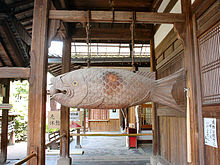Wood fish
The wooden fish ( Japanese mokugyo 木魚 , Chinese 木魚 / 木鱼 , Pinyin Muyu , Korean Moktak ) is a surcharge idiot from wood to the log drums belongs. Like the practically identical temple block and the simpler wooden block , the wooden fish is partially hollowed out by a slot or a round hole. It is used in various Mahayana Buddhist traditions , especially in Japan , China , Korea and Vietnam, as an accompanying instrument for recitations. In Zen / Chan Buddhism it is also used as a signal at the beginning and the end of a meditation unit and in Amitabha Buddhism as an accompaniment to Amitabha chants.
Meaning and form
The Korean word moktak has two parts: mok means wood and tak to beat. In Japan this instrument is called mokugyo , which translates as "wood fish". This name comes from the original shape of the instrument, which is reminiscent of a fish with an open mouth. Since fish do not sleep, they are a symbol of vigilance in Buddhism. The mokugyo is supposed to remind the reciter to be fully focused on the sutra being recited . There are mokuyos in a wide variety of sizes: from ten centimeters to over a meter.
Today mokugyos are usually no longer made in the shape of a fish's head, but only have a spherical shape with decorations. However, a special form is used in Buddhist monasteries in Japan to call the monks to eat in the morning and at noon. It is a mokugyo in the shape of a whole fish.
Emergence
There are many legends about the making of this musical instrument, most of which are played in China. One of these legends tells of a Chinese Buddhist who went to India to receive Buddhist texts ( sutras ). On his way to India he had to cross a wide river, but had neither a boat nor a bridge. At that moment a large fish swam to the surface. The Buddhist sat on his back and the fish brought him safely to the other bank. The fish then said that he had committed a bad deed in his previous life as a human which he is now trying to redress and asks the Buddhist to ask the Buddha whether the fish could become a bodhisattva .
The Buddhist agreed and continued his journey, which lasted seventeen years. After receiving the Buddhist texts, he made his way back to China. When he was about to cross the river again, the same fish came again. Again he helped the Buddhist cross the river. However, the Buddhist had forgotten his promise. When the fish found out, it got angry and threw the Buddhist and sutras into the river. A fisherman who happened to be nearby saved the Buddhist. Unfortunately, however, the sutras had disappeared in the floods.
When the Buddhist came home he was full of anger. Seventeen years' journey was in vain. In anger, he carved a fish head out of a piece of wood. In memory of his fate, he struck this fish head with a wooden mallet. To his amazement, the wooden fish opened its mouth at the blow and said one letter of the sutra. From now on he hit the fish's head as often as he found time and so after a few years he was able to regain the sutras, which had been believed to be lost, letter by letter.
literature
- Alan R. Thrasher :: Muyu . In: Grove Music Online , May 28, 2015
Web links
Individual evidence
- ↑ Moktak. ( Memento of April 9, 2010 in the Internet Archive ) Buddhadharma


